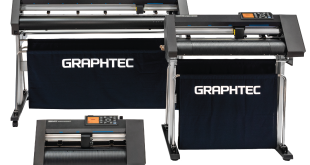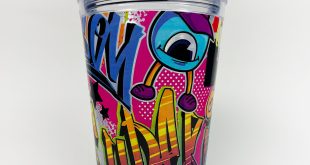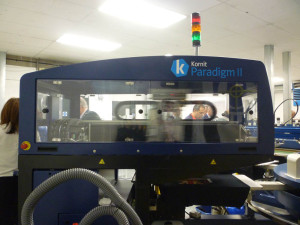
The Kornit Paradigm II is billed as the printer which bridges the gap between screen and digital print. P&P editor MELANIE ATTLESEY reports on this innovative piece of technology.
Regular visitors to FEPSA may be familiar with the Paradigm II, for it has made several appearances on the European show scene. This printer received its UK debut in 2013 when Kornit distributor Adelco demonstrated the screen digital combination at FESPA London.
And now in a push to bring the Paradigm II to the UK screen printing industry’s attention, Adelco held an Open House event on October 21 and 22, where the printer was demonstrated coupled with Adelco’s Ellipse Oval screen print carousel.
As Mark Smith from Adelco explained: “The Paradigm II has been available and offered from Adelco for around a year, but screen printers needed the ability to see the machine in action to understand how it can fit into their current printing methods.”
So what makes this printer stand out from the crowd?
Kornit is not looking to provide an alternative to screen printing or digital printing. Both have their place in garment decoration. The Paradigm II has been designed to provide an enhancement to the way that screen printers work.
The Paradigm II can be linked to any screen printing carousel and works by combining the techniques of screen printing with the benefits of digital printing. There are other hybrid printers out in the market, but these tend to be manual. Operators of these hybrid machines have to print onto a shirt on a platen by hand, pick up that platen, put it on a DTG machine and then print the T shirt again.
The operator of this screen digital combination begins by loading the image files onto the Paradigm II. Unlike a traditional carousel, the printer can handle more than one design at a time. To demonstrate the versatility of the printer, Adelco loaded 12 different designs onto the Paradigm II and printed one design, followed by the next design, in a cycle of 12. The Paradigm II print files can be fully automated, which is an advantage over a traditional screen print carousel. When an order is placed online via a web shop, it is loaded directly onto the printer in a print queue.
Once the operator has loaded the first T shirt onto the platen, printing can begin. The T shirt moves around the carousel in a similar fashion to a traditional one, but as it passes under each screen a different print layer is applied.
As the T shirt passes under the first screen a white layer is applied. This is an immediate advantage over digital printing. Why I hear you ask? Mark explains: “This printer uses no digital white ink. Most of the cost in digital printing comes from the white ink, which makes this a far cheaper system than any other digital printer out there. The cost of this printer is similar to printing a white T shirt on a fully digital DTG machine. This is around one third of a DTG print, which is necessary to be able to compete in the contract print market. The print cost is a vital part of the market. On a dark shirt we are talking around 25p a print, which on a Kornit DTG machine would cost around 85p. Making the screen digital combination significantly cheaper than any digital alternative.”
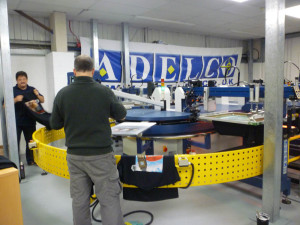
The T shirt is then flash cured, before it passes under the Paradigm II, where it is printed in CMYK with digital inks. High quality, photographic images can be printed, something that if a traditional screen printer tried to replicate would mean preparing around seven or eight screens. A screen printer would also have to ensure that each screen is perfectly aligned and set up. Each screen would also need to be cleaned down after use.
After the T shirt has been printed digitally elements of the design can be enhanced with the use of flock, foil, metallic and glitter inks. The T shirt is then flash cured for a final time before it is removed from the carousel and placed under a dryer. This whole print cycle can take as little as 25 seconds from start to finish.
How many T shirts can be printed per hour on this screen digital combo will vary depending on the number resolution used in the file image. At the highest resolution (600dpi) the combination will print approximately 160 T shirts an hour; if the resolution is lowered then T shirts will be printed quicker.
“If you lower the resolution, no detail in the image is lost,” explains Mark. “But because you are putting down less ink the colour is not as bright or as vibrant. A lot of images could be printed using a lower resolution because you wouldn’t notice the difference.”
At its fastest speed the Paradigm II is capable of printing approximately 200 T shirts an hour. It’s not as fast as a traditional carousel, but what sets it apart is the detail of the prints produced.
Axel Stuhlreiter, an application specialist with Kornit Digital, explains that the Paradigm II is aimed at screen printers looking to extend their offering to customers, by giving them the ability to print digitally onto textiles with photographic detailing.
He added: “The Paradigm II is beneficial for short runs and for complicated designs. It is difficult with screen printing to get the level of detail that can be achieved with the Paradigm II. With this screen digital combination you don’t have to worry about all of the preparation beforehand or the clean down afterwards. In the time it takes a screen printer to set-up, a run can be finished with the Paradigm II. This is a big, big advantage.
“Most screen printers do not want to block their carousels with short runs, because they are optimised for bigger runs. They are losing machine time if they do.”
Kornit realises that this printer is not going to be suitable for every printer. “If you are only ever printing in two or three colours and 20 T shirts at a time, this is not the right combination for you,” says Axel.
Another major advantage that the Paradigm II has is that it can be linked to almost any automated Oval or carousel. As Axel explains: “If the Paradigm II cannot be connected directly with the Oval or carousel to run automatically, then an optical sensor can be installed which will alert the Paradigm II that a new platen is coming and that it can start printing. The operator has to time how long it takes for a print to complete, so there are no misprints with the Paradigm II.”
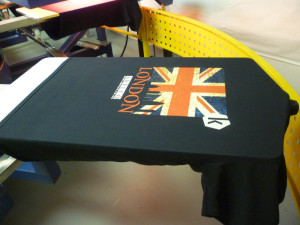
Over the course of the two-day Open House event, Mark estimates that 16 big screen printing companies attended and expressed their interest in the screen digital combination. This, Mark believes, was twice the number of UK visitors that attended Adelco’s stand at FESPA in Cologne earlier this year.
He added: “I think those who saw the printer in action were pleasantly surprised by it. If people begin talking about the combination as something that is real and happening, then the message will slowly spread throughout the industry. Printers talk to one another a hell of a lot, so hosting an event like this is important.
“We can tell printers what the advantages to this set-up are, but they have their own businesses and have to work out where this combination will fit in for themselves.”
 Printwear & Promotion The Total Promotional Package
Printwear & Promotion The Total Promotional Package
